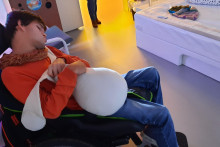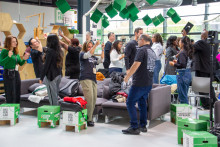At first glance, Orbee is a curiously shaped pillow with two arms and a ‘belly’ filled with buckwheat. ‘That means it’s heavy. The weight alone helps to calm down your nervous system,’ explains Neidlinger, whose work focuses on wearable technology which ‘shows extimacy - showing how you feel on the inside to the outside world’. A year ago she and Khiet Truong got the Responsible Design Grant for DesignLab project to co-design wearable technologies for PIMD clients at De Parabool’s care center De Schure. Now, the clients are testing her prototype and ‘so far they love it’.
‘The idea was to give them a voice using what they can do’
‘PIMD patients have a lot of physical limitations,’ says Neidlinger. ‘They are non-verbal, they often have troubles moving their hands, and so communication is a challenge. The idea was to give them a voice using what they can do. We collaborated with the clients, with their parents and caregivers to co-design technology based on their needs. For caregivers it was important to get something that would keep the clients active and entertained.’
Connected to the room
The result is Orbee, a multisensory wearable. The pillowcase has different textures to engage touch and the fabric itself offers another sensory experience: smell. ‘I incorporate pleasant smells in the fabric I make,’ explains Neidlinger. The pillow also contains biosensors which not only monitor the person’s breathing and heartrate, but which actually impact the direct environment.
‘The wearable is connected to the room,’ says the creator. ‘We have updated the design of a multisensory room with bioresponsive projections and even vibrations. I call it body gaming, as the biosensors in Orbee control the projections in the room. Based on the heartrate and breathing, the client journeys through various scenes like aquatic, forest, or abstract shapes, reflecting how the client feels.’
Instant meditation tool
The project is now in the very last stage and the prototype is being tested. Once the prototype is completely finished, Neidlinger hopes Orbee could find its way to care centers and hospitals across the Netherlands. ‘But I imagine it could even be useful for a larger population,’ she adds. ‘Due to Covid-19, anxiety levels are rising and just wearing Orbee has calming effects. Even the caregivers love wearing it. It could serve as an instant meditation tool. It can help you to be present in the moment. Because if you are present in the moment, your anxiety levels go down.’







